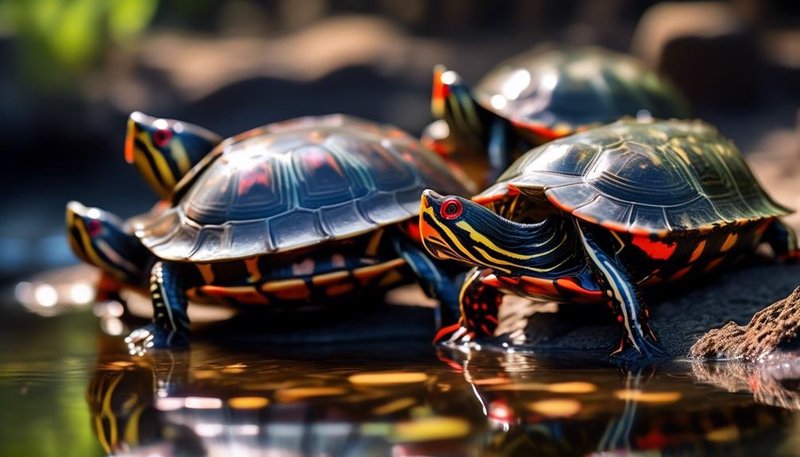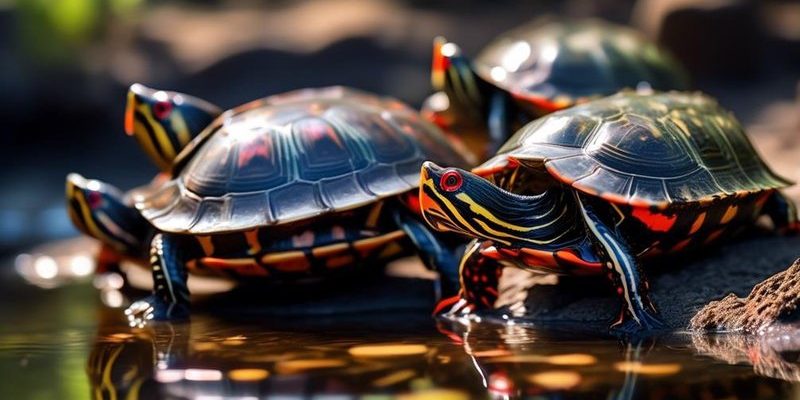
Understanding how painted turtles reproduce can feel like peeling back layers of a complex story. Imagine a romance that unfolds in the sun-drenched wetlands, where everything from temperature to timing plays a crucial role. In this article, we’ll explore their mating habits, nesting behaviors, and the challenges they face along the way. By the end, you’ll not only appreciate these beautiful reptiles more but also have a clearer understanding of how their life cycle works.
Understanding the Painted Turtle’s Mating Season
The mating season for painted turtles typically occurs in spring, around April to June, depending on where they live. This is when temperatures rise, and the turtles become more active after the long winter slumber. Honestly, it’s like they’ve been waiting all winter for the sun to come out so they can finally meet their mates. During this time, you might see male painted turtles engaging in playful courtship rituals, which can be quite a sight.
Males often swim around females, displaying their best features, like their vibrant colors and interesting patterns. They might also engage in a little gentle nudging, which is their way of saying, “Hey, look at me!” Once a female is receptive, the pair may mate several times over a few weeks. It’s a bit like a mini-turtle prom, with each male vying for the female’s attention, hoping to win her favor.
Nesting Behavior: Finding the Perfect Spot
Once the mating dance is complete, it’s time for the female to nest. Painted turtles are very picky about where they lay their eggs, and for good reason. The right environment can be the difference between life and death for their hatchlings. Typically, females seek out sandy or loose soil near water sources, a bit like how we might search for the best picnic spot. This is crucial because it allows for proper drainage and warmth, which are vital for the developing eggs.
After finding a suitable spot, the female digs a hole with her back legs, a task that can take quite some time. She usually lays between 4 to 20 eggs, depending on her size and health. Once the eggs are laid, the female covers them up and heads back to the water, leaving the eggs to develop on their own. Here’s the thing: painted turtles don’t care for their eggs after laying them. It’s all about survival of the fittest from this point onward.
The Incubation Period: A Waiting Game
Now that the eggs are laid, an incubation period of about 60 to 90 days begins. During this time, the eggs are highly vulnerable to predators like raccoons, birds, or even other turtles. It’s a tough world out there, and many eggs don’t make it to hatching. The temperature also plays a critical role during this time; warmer temperatures usually yield more females, while cooler temperatures tend to produce more males. Talk about nature’s way of keeping things balanced!
Interestingly, painted turtle eggs can survive some pretty harsh conditions, such as cold temperatures and even minor flooding. This resilience allows hatchlings to emerge at different times, which can be an advantage for survival. Once the little ones finally break free from their eggs, they must make a dash to the water—a tricky journey filled with potential dangers.
Hatching and Survival: The Journey Begins
When hatchlings finally emerge, they are incredibly tiny, usually about the size of a quarter. You might picture them as little adventurers setting off on a grand quest. Their first order of business is to reach the water safely, where they’ll have a better chance of survival. However, this journey is fraught with dangers, including predators and environmental hazards.
Once in the water, the young painted turtles will stay close to the shore, hiding among rocks and vegetation. They’re like little ninjas, blending in to avoid becoming someone’s meal. As they grow, they develop their skills in swimming and foraging, gradually gaining independence. However, it takes several years for them to reach maturity, usually around 5 to 10 years, depending on their environment and food availability.
The Role of Environmental Factors
Several environmental factors can influence painted turtle breeding and reproduction. Temperature, humidity, and even changes in habitat can significantly impact their behaviors. For instance, climate change poses a real threat to their nesting sites. Rising temperatures can lead to more female hatchlings, which can skew the population dynamics over time.
Additionally, habitat destruction, such as urban development or pollution, can limit the areas suitable for nesting. When these turtles lose their preferred nesting spots, it can lead to a decline in their populations. There’s no denying it: the painted turtle’s survival is linked closely to the health of its environment.
Conservation Efforts: Protecting Painted Turtles
As you can see, painted turtles face many challenges throughout their breeding and reproductive cycles. Thankfully, various conservation efforts are underway to protect them. Many organizations focus on habitat restoration, conducting studies on turtle populations, and educating the public about the importance of preserving these creatures.
Simple actions, like protecting nesting sites and reducing pollution, can have a big impact. Community awareness plays a critical role, too. When people understand the life cycle of the painted turtle, they’re often more willing to help. Whether it’s creating safe nesting areas or participating in clean-up days, every little bit helps!
In conclusion, the breeding and reproductive behavior of the painted turtle is a remarkable journey filled with challenges, adaptations, and resilience. From their playful courtship to the precarious life of hatchlings, each stage is crucial for the survival of this captivating species. As we continue to learn about these amazing creatures, it becomes clear that supporting their habitats and understanding their needs is vital for their future.
So next time you see a painted turtle basking in the sun, remember the intricate life cycle behind it. With every turtle, there’s a beautiful story of love, survival, and the delicate balance of nature waiting to unfold.

